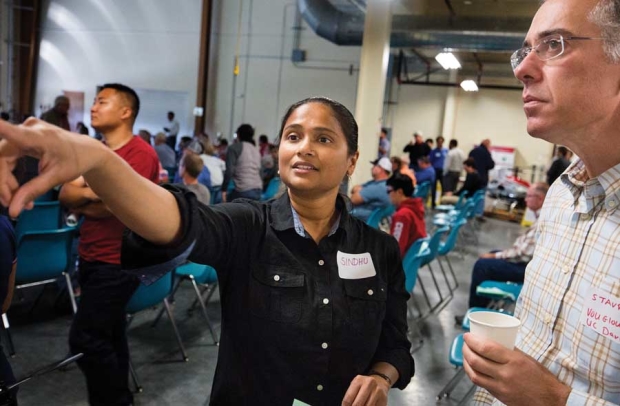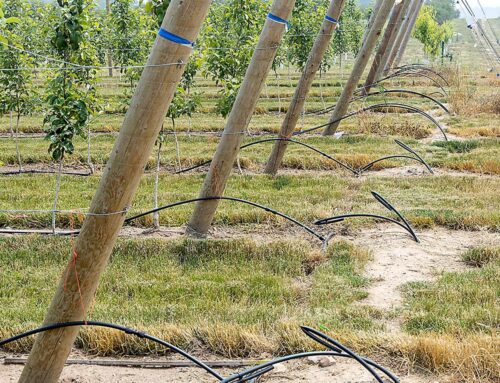Researchers have made strides in the study of fruit genomics in recent years, but less ground has been gained in the field of phenomics, the measurement of plant and fruit traits.
Genotyping and phenotyping go hand in hand; one must know if a specific fruit trait is present, and in what form, in order to tie the trait to a specific gene.
Conventional phenotyping is done visually, such as by recognizing disease symptoms and severity or fruit color ratings, or by using other standard, labor-intensive techniques pertinent to the trait of interest.
They could include caliper measurements for fruit size or destructive chemical methods to determine a fruit’s chemical composition.
New, non-contact, rapid-sensing techniques, including miniature portable multispectral and thermal infrared cameras, are emerging for high-throughput field phenotyping.
Dr. Sindhuja Sankaran is working with a team of researchers to apply these techniques in research projects of grapes and apples in Washington State.

Dr. Sindhuja Sankaran, assistant professor of Biological Systems Engineering for Washington State University, speaks to University of California assistant professor Stavros G. Vougioukas at the CPAAS open house and Agricultural Technology Day in Prosser, Washington on September 17, 2015. (TJ Mullinax/Good Fruit Grower)
A Washington State University biological systems engineer, Sankaran is focusing on the development and integration of sensor technologies for crop phenotype monitoring to support plant breeding, crop plant research, and precision agriculture applications.
Specifically, she and her team deploy technologies for non-invasive, rapid, continuous monitoring of a plant’s responses to its environment. Sankaran previously performed similar research on row and field crops.
A range of sensors can measure for plant and fruit characteristics, and the team is using those to quantify crop stressors and nutrients, among other things, Sankaran said. Some of the sensor examinations can be more comprehensive, taking into account the health of an entire tree or vine, rather than leaf-level measurements.
This approach is what makes phenotyping rapid and that, in a high-throughput manner, can help researchers quantitatively understand traits in the field with ease, she said.
Field work
For one study, Sankaran and her team are deploying sensors in the field to assist Dr. Pete Jacoby, a WSU soil scientist, to research new and advanced methods of subsurface drip irrigation for Washington wine grape growers.
The study compares plant responses to water applied at subsurface depths of up to four feet and water applied via surface drip irrigation. The goal: reduce costs associated with pumping water and help conserve water resources by curtailing water loss to weeds and evaporation.
Subsurface irrigation doesn’t allow you to see when it’s plugged up or working incorrectly, Jacoby said, and running remote sensors through the vineyard periodically enabled researchers to recognize and address early warning signs of heat stress on the vines.
“We’re also working with Sindhuja Sankaran to help evaluate the level of stress we’re putting on with our treatments, because we’re putting on far less water than the commercial vineyard operators apply, and we’re putting it directly on or slightly below the root zone,” he said.
So far, Jacoby said, researchers have applied as much as 85 percent less water to vines, and none have died. “In fact, we’ve harvested quite a number of grapes.”
The optimal amount of water remains to be determined, which is where Sankaran and her team come in, using visible and near-infrared sensors that have the capabilities of seeing plant responses between 350 and 2,500 nanometers. (The human eye can see between 400 and 700 nanometers.)
The approach is to use both ground and aerial-based spectral data and relate it to realities in the field. The cameras can potentially measure differences in the canopy temperatures representing different transpiration rates of the plants and normalized difference vegetation index (NDVI) indicative of plant health, among other things.
The researchers gathered data once every month during the growing season at multiple locations, examining the same crop blocks each visit for comparison.
The high-throughput technology has been great to work with so far, Jacoby said.
“I’ve been impressed with it; it’s very straight-forward,” he said. “For us to go out and take measurements in the vineyards, we’re only sampling very few plants because of the time constraints. We’re able to look at the entire treatment block in one single pass, which saves time. We plan next year to do it more frequently.”
In another Washington Tree Fruit Research Commission-funded project led by WSU plant physiologist Dr. Lee Kalcsits, Sankaran and her team used multispectral cameras to measure the effects of calcium and abscisic acid on apple trees that have been treated with different calcium rates to ward off bitter pit.
“We know that some of the sensing techniques can be used for measuring differences in transpiration rates,” Sankaran said. “We want to see if these spectral differences from canopies treated with varied calcium concentrations can translate to transpiration rates.”
These high-throughput technologies are limited in that the standards and techniques applied for the study of one crop may not be applicable for another crop, she said.
The threshold at which the sensors can be used to point out differences also varies from crop to crop, meaning that plant stress that may be detected even before the symptoms are visible to the human eye in one crop may not be detected in another crop. The technologies’ usefulness will vary by crop and by condition.
“Each crop is unique. That’s going to be the limitation for it,” she said, but added, “These sensing techniques have a great potential, and with proper validation studies, such technology can help growers in making real-time decisions for managing their vineyards or orchards.” •
– by Shannon Dininny






Leave A Comment